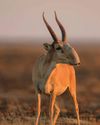Perilously close to extinction 100 years ago, the Asiatic lion has made a remarkable recovery. Sarah McPherson reports on the combined efforts that made it happen – and what lies ahead.

We never really think of India as lion country. Lions belong on the savannahs of Africa, patrolling the long grass and reclining on rocky outcrops. India, surely, is tiger country, where these iconic cats rest on crumbling temples and cool off in mirror-calm pools.
Yet India, too, has lions. These are members of the Asiatic subspecies, descendants of those that left north Africa some 21,000 years ago and dispersed as far as Europe and south-west Asia. But then came a succession of Mughal emperors, maharajas and colonial rulers with an insatiable thirst for trophy hunting. One by one, India’s states emptied of lions. By the early 1900s, the subspecies was confined to a relic population of just 20 or so individuals in Gir, a region of rolling dry forest, scrubland and savannah in the western state of Gujarat. It was only the last-ditch intervention of two successive ruling princes that prevented these cats from vanishing for good.
Since then, thanks to decades of in-depth conservation work and extraordinary support from local people, the Asiatic lion has clawed its way to recovery, with numbers soaring to 523 at the most recent count in 2015. “It’s one of the greatest conservation success stories in the world,” says Gitanjali Bhattacharya, biologist and manager of international conservation charity the Zoological Society of London’s (ZSL) South and Central Asia programme. “The Asiatic lion is now flourishing in its landscape. Not only has its future been secured, but it’s even starting to regain some of its old territories.”
Much has been invested in safeguarding the subspecies, with conservation efforts spearheaded by the government-funded Gujarat Forest Department (GFD). The human landscape bears obvious signs of husbandry towards the lions: signs instruct trains to slow to 20kmph; wells are covered or adapted with parapets; water sources are provided.
هذه القصة مأخوذة من طبعة January 2017 من BBC Wildlife.
ابدأ النسخة التجريبية المجانية من Magzter GOLD لمدة 7 أيام للوصول إلى آلاف القصص المتميزة المنسقة وأكثر من 9,000 مجلة وصحيفة.
بالفعل مشترك ? تسجيل الدخول
هذه القصة مأخوذة من طبعة January 2017 من BBC Wildlife.
ابدأ النسخة التجريبية المجانية من Magzter GOLD لمدة 7 أيام للوصول إلى آلاف القصص المتميزة المنسقة وأكثر من 9,000 مجلة وصحيفة.
بالفعل مشترك? تسجيل الدخول

SNAP-CHAT
Justin Gilligan on giant spider crabs and holding hands with an octopus

STEPPE CHANGE
Herds of saiga have returned to Kazakhstan, but there's a fine balance to tread

TREES FOR LIFE
Community is at the heart of conservation in the tropical forests of southern Belize

WHEN DOVES CRY
Turtle doves are now the UK's fastest declining bird species, but the RSPB is on a mission to save them

SURVIVAL OF THE CUTEST
We can't help being drawn to cute creatures, but our aesthetic preferences both help and hinder conservation

LIGHT ON THE NORTH
Spectacular images of Arctic foxes, reindeer and musk oxen reveal the wild beauty and diversity of Scandinavia

ROLLING IN THE DEEP
The super-sized crustacean that lives in the deepest, darkest ocean

LET'S GET TOGETHER
Clay licks deep in the Amazon explode in a riot of colour, with macaws the stars of the show

FEMALE OF THE SPECIES
To sponge or not to sponge? That is the question for the bottlenose dolphins (Tursiops aduncus) living in Shark Bay, Western Australia.

7 nature encounters for the month ahead
WITH NATURALIST AND AUTHOR BEN HOARE